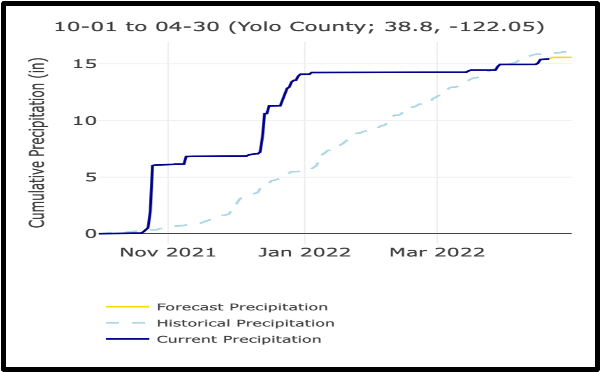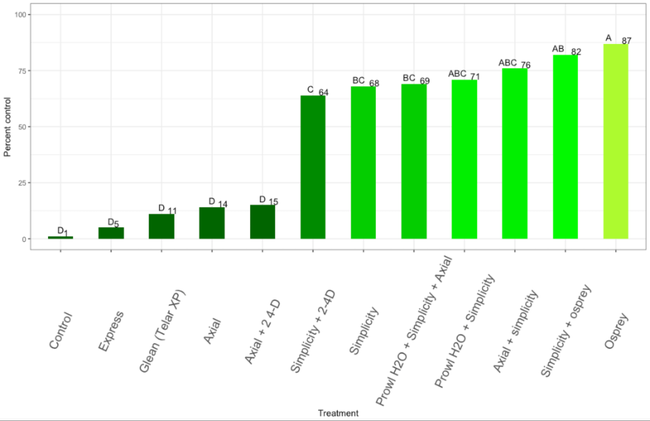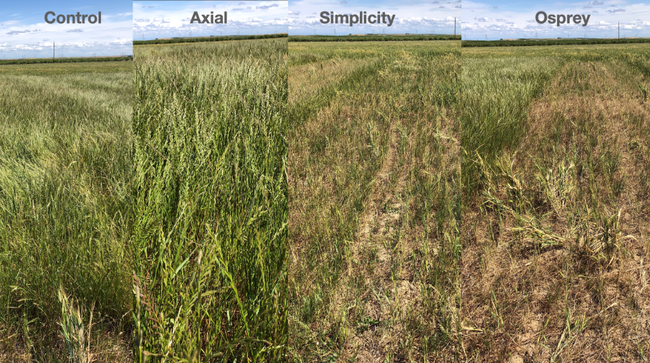Summary note: This is a belated research update from herbicide trials (targeting Italian ryegrass) carried out in the winter of 2021-2022 in wheat fields in the Esparto area. The southern Sacramento Valley saw a record number of consecutive days without rain in that year, which severely limited the efficacy of post-emergent systemic herbicides. Growers should prioritize scheduling post-emergent herbicide applications early in the weed's growth stages and when weeds are actively growing to avoid the severe reduction of herbicide efficacy that can occur as a result of unexpected droughty conditions. This is particularly important given that the weather systems in our area are unpredictable between December and February and will often dissipate as they approach the Sacramento Valley.
...
Hot days would seem to indicate that we are nowhere near wheat season, but unpredictable weather patterns as early as October can make weed management difficult. As we approach winter, it's worth taking a minute to reiterate some of the interactions between herbicide efficacy and drought conditions that we witnessed in what was a very dry winter (2021-2022).
Italian ryegrass: a widespread weed with a track record of herbicide resistance
Italian ryegrass (IR), like Palmer amaranth and horseweed, is known for its capacity to develop herbicide resistance. In order to address resistance issues in IR, the University of California Cooperative Extension (UCCE) has been looking into the various ways in which growers can reduce IR populations through the use of available herbicides as well as mechanical cultivation techniques. Some of these lessons are valuable not only in winter rotations, but also in summer cropping systems.
2022 Herbicide Trials: a perfect storm
If there's one thing we learned in the spring of 2022, it was how severely drought conditions can reduce the efficacy of herbicides. In short: drought-stressed weeds are much harder to control with postemergence herbicides.
Figure 1. Cumulative rainfall from 2022. Flat parts of the curve are indicative of drought periods.The season was characterized by feast/ famine rainfall patterns. Heavy rainfall followed by long periods of drought stress produced conditions that dramatically reduced herbicide efficacy.
Substantial early rains in October of 2021 led to early germination of IR in the trial. Burndown applications were delayed due to wet field conditions throughout most of November and December and wheat was planted during a brief window of time in December.
The herbicides for the post-emergent trial were sprayed in late-January when wheat was at the tillering growth stage (Feekes 2) and ryegrass had 2-3 tillers and was about 6” tall.The ryegrass was still within the size recommendation on the herbicide labels; however, drought conditions had begun to set in three weeks prior to treatment.
The area where the trial was located saw no rainfall for 70 days after the herbicide application. The dry spell lasted 92 days in total, the longest in the region since the 1920s.
Results / Discussion:
The absence of a burndown application allowed for competitive weed growth that stunted the crop
The fact that the planned December burndown spray had to be canceled meant that the early-emerging weeds continued to grow alongside wheat. By January, the impact of the weed competition on the crop stand was severe. Although in-season herbicides suppressed the ryegrass and other weeds, much of the damage from competition had already been done. Most wheat plants were severely stunted and had only one or two reproductive tillers, the wheat spikes were shortened and had far fewer seeds per tiller at harvest than you would expect with an average crop stand.
Drought conditions reduced herbicide efficacy dramatically
It took more than 30 days before the IR in the trials began showing a significant amount of damage in response to the herbicide application. When damage assessments were taken on March 7th (38 days after application), where 0 indicated ‘no damage' and 6 indicated ‘total control', the highest rating was a 4.5 via a tank mix of Simplicity and Osprey. In other words, none of the plots had been controlled after more than 5 weeks.
After a few light showers in late March, the IR resumed growth and rapidly declined as herbicides began to finally take effect. Despite the increased impact of the herbicides, overall control was still sub-optimal, with the highest control ratings being between 71 and 87 percent. Axial, which had performed well in this exact field two years prior ended up with very low levels of control (14%). The reduced efficacy was likely due to drought stress, weeds hardening off, or simply because the herbicide was affected by some amount of decay in the field before it could be fully taken up by the plant itself. This was a good reminder that researchers and growers should consider other externalities before they throw their hands up and say the “R” word (resistance).
In both summer and winter crops, if plants are healthy and actively growing, herbicides will be much more effective and should work within the weed growth stage ranges specified on the label. However, because weather patterns can be unpredictable, the windows for herbicide labels should be seen as somewhat optimistic (written for ideal conditions).
Yields in the trial area ended up being one quarter of what they normally would be in this field due to a combination of early weed competition from the missed burndown treatment and the effects of a persistent drought period which both stressed the crop and reduced the efficacy of the applied herbicides.
Takeaways:
Spray windows on herbicide labels are often somewhat optimistic and assume that plants are actively growing (labels for systemic herbicides will typically specify that applications be made to actively growing weeds). Because drought can't always be predicted, growers should prioritize herbicide applications early in the weed growth stages and should apply herbicides when weeds are actively growing. In cases where irrigation is an option, growers should consider an irrigation event if conditions are excessively dry as it can greatly improve the efficacy of an herbicide (not to mention the fact that a small grain crop will likely be able to utilize the soil moisture as it enters the rapid growth phase in late winter).
The trial results are a strong example of how herbicide efficacy is tied to a number of factors. It is also an example of how researchers can serve their clientele by demonstrating how much things can go wrong when environmental conditions collide with their own optimism and the idealized ranges of herbicide labels.
Figure 2. Percent control of Italian ryegrass in a wheat field experiment in 2022 near Esparto, CA. Treatments were applied in January and these ratings were made on April 15th (80 days after herbicide applications, and following a few small showers in March that provided enough moisture for plants to continue growing). Note that Axial, which had worked well at this location in the previous years was largely ineffective under these conditions. It is highly unlikely that this is due to resistance, but rather is an example of how drought conditions can impact herbicide efficacy.
Figure 3. Plots in Esparto trial area in April (80 days after herbicide treatments). By the time herbicides began to impact Italian ryegrass, wheat was already severely stunted. This is an example of how critical early weed control and burndowns can be. Note again that Axial, which has worked well in this field two years prior, was dramatically less effective due to drought conditions. As an ACCase inhibitor, Axial is a valuable tool for growers looking to diversity their herbicide program, but this is an example of why it is important to prioritize early applications of herbicides on actively-growing weeds.


